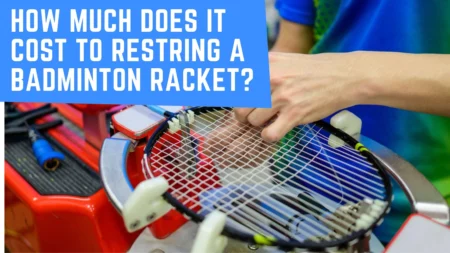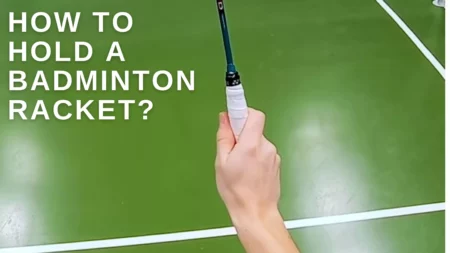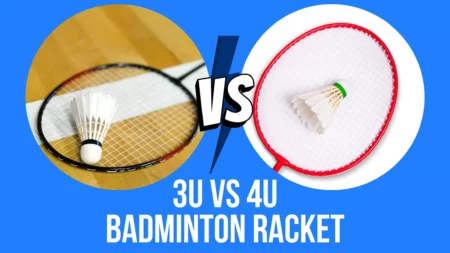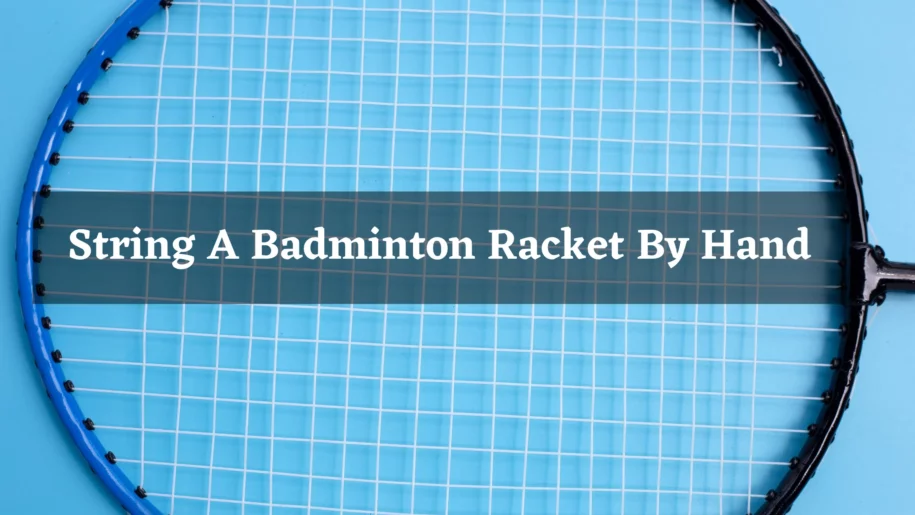
String a badminton racket by hand is not difficult!
Yup! Not difficult.
But it can be time-consuming.
Now, the question is how to string a badminton racket by hand.
With the help of a machine, it will be easy to string the racket and make sure that it is done perfectly.
The process of stringing a badminton racket by hand is not difficult, but it can be time-consuming.
As You Know!
Badminton is a popular sport in the modern world.
It is also one of the most expensive sports to play.
There are ways to make your own badminton racket,
So that you can save money and maintain a high level of consistency in your game.
How To String A Badminton Racket By Hand
What Is Racket String?
Racket stringing is a process that takes place in the early stages of playing badminton.
Strings are the most important part of a badminton racket.
They allow players to hit the shuttlecock with more power and consistency.
The right string can make or break a player’s game,
So it is important to know what type of string would be best for you.
How To Select Right Strings?
It is not just about skill level.
There are other factors that come into play when choosing the right strings for your game.
For instance, if you have a low skill level,
You may want to consider using lighter strings in order to make sure that you are not getting fatigued too quickly and making mistakes with your shot selection.
If you have a high skill level, then heavier strings will give you more control over your shots and help improve your consistency in hitting the shuttlecock at different speeds.
Brief Guide Of How To String A badminton Racket By Hand
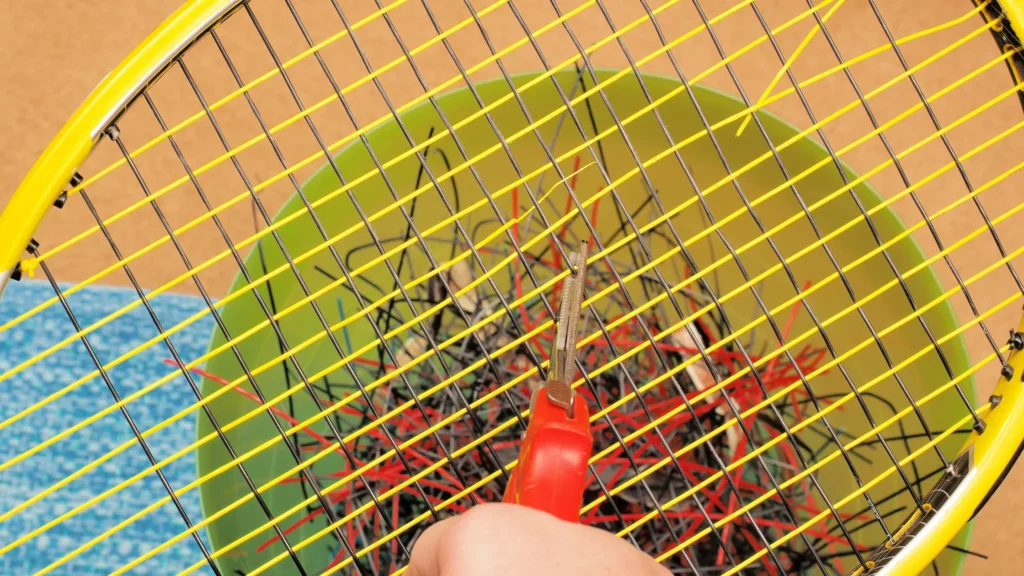
Stringing a badminton racket by hand is not difficult, but it can be time-consuming.
Stringing a badminton racket by hand is to choosing the correct size of string for your racket.
The size of the string should be chosen according to your height and weight.
Cutting the strings with scissors or a knife so that they are long enough for you to tie them together.
This article will teach you how to tie your own badminton racket strings, which can be done very quickly and easily at home with just a few tools and materials available in most households.
Moreover,
- Considerations Before Stringing a Racquet
- Items Required When Stringing a Badminton Racket
- Preparation for How To String A badminton Racket By Hand
- Steps How To String a Badminton Racket
- How will Long the Strings Last?
- How Much Cost Are Used In String a Badminton Racket
- Some Stringing Badminton Kits
- Stringing Badminton Machines
Things Should Be Considered Before Stringing A Racquet
Before Stringing a Racquet, know the type of string, correct tension, and the string pattern you want to use. For that reason, take note of the following:
1. Diameter of String
What you can choose as a necklace cord is either thin or thick.
The thin ones last longer than the thick, ones but require more frequent maintenance.
But since they are thick, thicker strings can be overpowering in your racket game.
On the other hand, thinner strings might offer better performance for you, for example by supporting shots from a distance.
On hitting the shuttle, thinner strings produce a solid (pleasant) sound.
Because of the thin diameter of these strings, they only last for a short amount of time.
This means you would have to re-string your racquet more often than with thicker strings.
2. Tension of String
To determine the maximum tension on your framework,
You should know how many pounds per square inch (PSI) the material supports.
If your strings are tightened beyond this level, there could be a wide range of adverse effects in terms of frame durability.
Beginners players of badminton should have a low string tension to reduce the risk of injury but will need to increase their skills.
Advanced players of badminton might want to try a higher tension – whether from 30-40lbs or even more!
Some rackets are available with different weights in the frame to improve the game for different players.
For example, a lighter racket might be better for people who need more accuracy and timing,
Whereas a heavier one would make more power possible for those new to the sport.
The tension of a racquet is indicative of what kind of player this will work best with- not just beginners.
Items Required When Stringing A Badminton Racket
Before you start the stringing process, there are a few items you will need.
- Strings
- Badminton racket
- Pliers
- A ruler
- Awl
- Clippers
Preparation for How To String A badminton Racket By Hand
Before you start the process of racket stringing, it is important to decide on certain aspects of it, like the string tension and diameter.
1. Trim Down The String
You can use a sharp knife to cut through the frayed, broken strings by removing them from the middle of the fabric.
Begin by cutting a line from one side to another and then gradually curving it into a line made up of connection strings.
2. Remove The Gap
In case the strings need replacing, take a closer look at the grommets.
Look out for worn-out or missing ones.
If few require replacement, fix them before stringing up anything.
3. Check For Fraying
You want to check the condition of the frame when you’re inspecting it for possible strings or repairs.
Inspect the framework for cracks or broken joints, as well as signs of tension.
It can help to inspect it with a pair of string line testers.
When you notice a crack or if the racket is broken in any way, it may be worth repairing before stringing.
If you don’t want to spend the time doing it yourself, take it to a professional at a local store.
Steps How to String A Badminton Racket
Basically two types of stringing Badminton rackets.
Vertical Strings
The best way to string a badminton racket is to begin by threading the vertical cords.
- Thread the string through one end of the racket, with enough slack to go around the bottom-most hole on top of it. Then pull out enough slack to go through the same location on the other side.
- After that, pass the string around both the top and bottom holes. Then take down the string to the bottom of your racquet, where you began.
- To ensure the string reaches both sides of the shaft, you should have each side of the cords hanging on either side. Adjust the ropes to achieve equal distribution.
- Stretch the thread so it forms a long loop and move it out to one side. Then take a few more loops this way, until it completely circles the frame. Add as many cords as needed to get the correct length, and then continue with steps 2 & 3 on the other side of the frame.
- The rope should have ample length for tying a knot. If it is too short, consider thinning out strands to obtain the desired length.
- Tie a knot around the top of the initial section to prevent it from slipping out.
- You should begin with the outermost thread and make a knot at the end. Then, you should adjust the tension of each strand until they all reach their desired strength.
- Start making a series of knots on the opposite side of your remaining racquet. On the farthest side, you will make a single knot. Then, you should continue your pattern across each other knot so that it forms a straight line along with the entire frame.
- When knot tying enters tightness, the tension of your rope string is not enough. A person will then use pliers to keep the slack of the string while they tie a knot. The best way to do this is to make sure the first edge has made contact with the pliers and that everything is contracted.
Horizontal Strings
- Thread the string through the hole and make a tight knot from the inside of the frame.
- When you’re making links, you’ll find the number of strands in the vertical rope is odd and the number of strands in the horizontal rope is even. For these strands to match each other, it’s necessary for them to switch places.
- First, start bypassing the string over and under the vertical strings until you reach the equivalent hole on the other side. Then, make sure to keep your line tight by not crossing it over any other strand as you continue making your knots!
- Keep it up all the way to the end where we start on a horizontal row again. This should be continued till you reach the place where you will want to wrap around the head of a hook before proceeding.
- After carrying out the steps below, you should create a big, tight knot on the end of the string to prevent it from slipping back. You can do this several times to create a large, soft mound.
- Cut the excess string hanging from the knot with a sharp knife. However, leave some residue from the knot. If the string is slack, pull each string and tighten it all at once to improve the tension of your racquet.
How Will Long The Strings Last?
Sometimes there may be a need for a restringing of your racket.
This depends on the frequency with which you play the game and how much use it is getting.
Professionals may want to restring their equipment more often than 3 months.
Experienced players of badminton can feel when the strings need to be tightened or loosened, or if a string breaks they will need to replace it immediately.
How Much Cost Are Used String A Badminton Racket
Buying badminton equipment yourself can be pretty inexpensive if you are willing to do the work yourself,
But at a professional sports shop, or paying an outside coach, the cost might seem quite a bit higher.
The cost of a badminton racket depends on the quality.
If you are first or second buying rackets, the cost of stringing rackets will not be very expensive.
It is important to find a quality racket that is within your price range so you don’t spend tons of money.
When you decide to buy a DIY badminton stringing kit, you can piece together the materials with the help of online information.
Kits come in various qualities, some of which include pliers and string hook/awl.
In order to ensure that you get the intended result from your purchase, make sure you find out what needs to be purchased beforehand.
Some Stringing Badminton Kits
- Babolat
- Gamma
- Yonex
- Ashaway
- Eagles
String Badminton Machines
- Tourna
- Prince NEOS
- Pro Stringer
- Klippermate
- Gamma
Conclusion
If you’re looking to string your badminton racket on your own then it’s up to you.
However, it will be easier & less stressful for someone else to do it for you when they have a stringing machine.
It’s quick and seamless when someone does it for you instead of spending time doing your own work.
Also, you know it is going to work and there won’t be any mistakes.
Stringing can be done by almost anyone.
Beginners and professionals alike and is an extremely affordable hobby to pursue if you’re so inclined.
There are plenty of resources out there with tutorials, video content, and even bundles of strings & patterns!
FAQS
How do you wire a badminton racket?
The process of wiring can be done in four steps:
1) Make sure your wire has enough thread.
2) Place your needle in its eye.
3) Thread your wire through your needle’s eye.
4) Attach your strings.
Can I restring my own racket?
Yes! You can do it yourself if you have the right tools and know-how on how to restring a racket without hurting yourself or damaging your equipment.
How much does it cost to restring a racket?
The average cost to restring a tennis racket is $40, but it can range from $15 to $75. Costs are split between labor ($10-25 per racket) and strings ($2-50 per set).
Which string is best for badminton?
1. Yonex BG 66 Ultimax Badminton String.
2. Yonex BG65 Badminton String.
3. Yonex BG 80 Badminton String
How do string Savers work?
String savers are a device that uses a spring to hold a string and keep it from tangling. They are used in various places like offices, bedrooms, garages, and kitchens.


